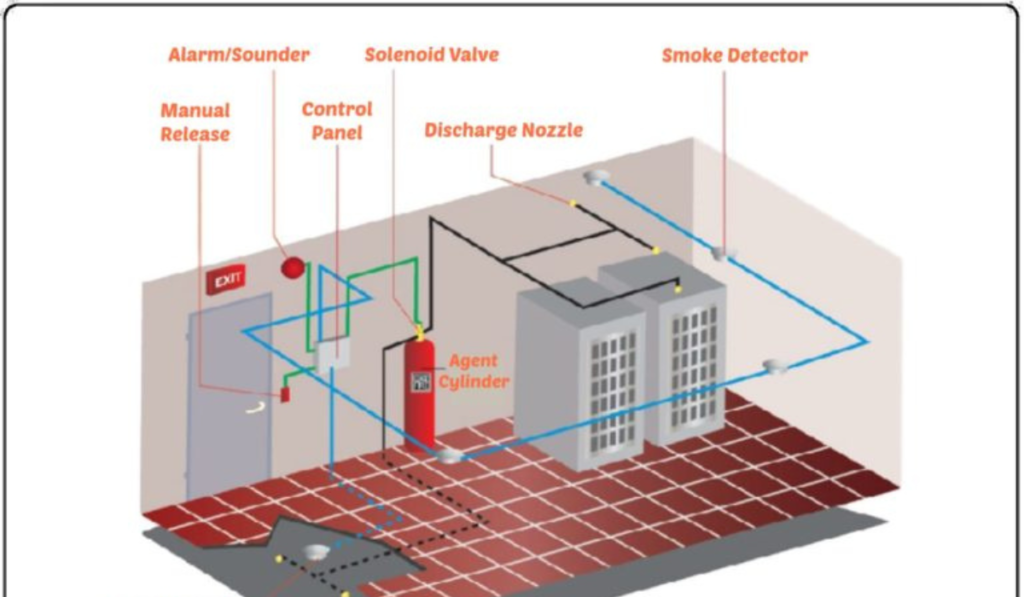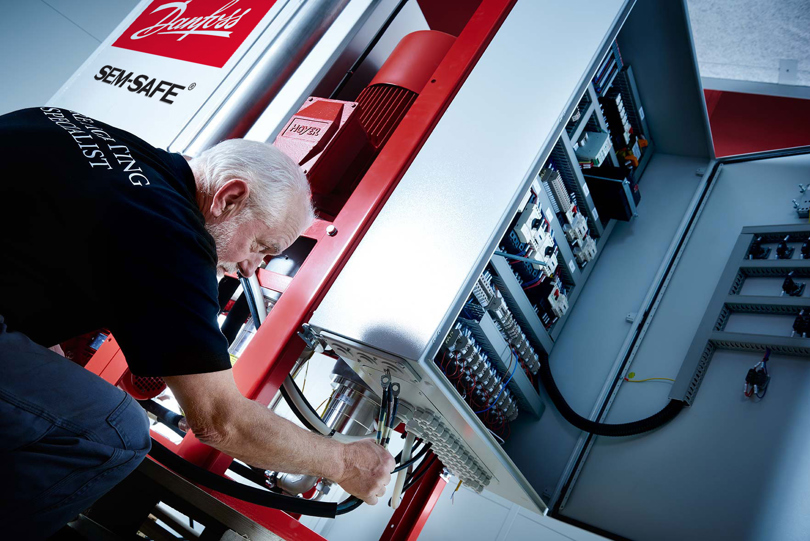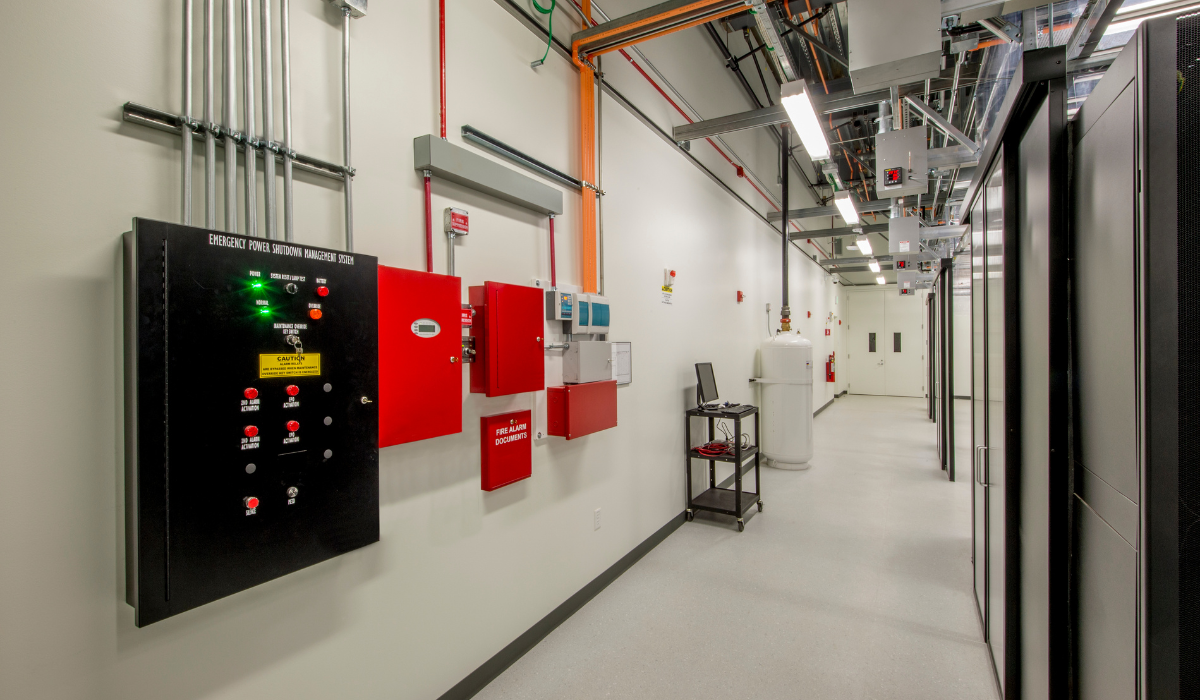Data center fire suppression systems are critical for protecting IT assets from fire damage. They deploy automatically to extinguish fires without harming sensitive equipment.
Data centers are the heart of our digital universe, housing the critical infrastructure that powers our connected world. As such, safeguarding these facilities against fire-related disasters is paramount for maintaining data integrity and operational continuity. To address this, modern data centers are equipped with advanced fire suppression systems, designed not to damage the delicate electronic equipment they protect.
This involves the use of clean agents like FM200 or NOVEC 1230, which can quickly put out fires without leaving a residue. Suppressing a fire at its source minimizes downtime and helps to prevent catastrophic data loss. Keeping these systems up-to-date and in compliance with the latest safety standards is a priority for data center managers, as is ensuring that they cause the least possible disruption to digital operations during their deployment.

The Threat Of Fire In Data Centers
Data centers are critical to the operations of countless businesses. Keeping servers and hardware safe from the threat of fire is paramount. Fires can cause catastrophic data loss and significant financial damage. In this section, we explore the common reasons for fire breakouts in these facilities and the impacts they can have on operations and safety.
Common Causes Of Data Center Fires
Fires in data centers often arise from identifiable sources. Key culprits include:
- Electrical failures: Short circuits and power surges.
- Overheating equipment: Poor ventilation or cooling system failure.
- Cabling issues: Damaged or improperly installed cables.
- Human error: Accidental triggers from maintenance work.
Impacts On Operations And Safety
A fire in a data center does not merely stop at equipment loss. It has widespread effects such as:
| Downtime | Data Loss | Health Risks |
|---|---|---|
| Interruptions in business services | Irreversible damage to stored information | Potential harm to staff and emergency personnel |
Financial setbacks from such incidences reach well into the millions. They also erode customer trust and shake company stability. Ensuring robust fire suppression systems can save both lives and data from the flames.
Essential Fire Suppression Strategies
Protecting data centers from fire is a top priority. Sensitive equipment and valuable data need the best defense against fires. Advanced fire suppression strategies help to ensure safety. They tackle fires fast without damaging equipment. Let’s explore the key tactics to keep data centers safe.
Detection Technology And Systems
Detection is the first line of defense in fire suppression. It spots fires before they spread. Here’s how it works:
- Heat detectors: Activate when they sense high temperatures.
- Smoke detectors: React to smoke particles in the air.
- Multi-sensor detectors: Combine multiple sensing methods for accuracy.
Modern systems link to alarms and the suppression system. They work together for a swift response.
Chemical Vs. Inert Gas Suppressants
Choosing the right suppressant is critical. It should put out fires without damaging tech. Both chemical and inert gas suppressants have their roles.
| Suppressant Type | How It Works | Pros | Cons |
|---|---|---|---|
| Chemical | Interrupts the combustion reaction. | Fast-acting, requires less space. | Potential residue cleanup. |
| Inert Gas | Lowers oxygen levels to stop fire. | No residue, safe for equipment. | Requires more storage space. |
Chemical suppressants work quickly and are efficient in confined spaces. Inert gases are clean agents. They preserve sensitive machinery but take up more room. Your choice depends on space, budget, and the type of equipment protected.
Modern Fire Suppression Solutions
Protecting data centers against fire is crucial for safety and continuity. Innovative solutions now exist to combat these dangers effectively. This section explores advanced fire suppression technologies that safeguard critical infrastructure without harming equipment or the environment.
Clean Agent Fire Suppression
Clean agent systems offer fast, efficient and residue-free fire suppression. They use chemicals that evaporate quickly and don’t damage sensitive equipment. Here’s a breakdown of how they operate:
- Zero residue: Leaves no particles behind, preserving electronics and data storage devices.
- Rapid response: Extinguishes fires within seconds, minimizing damage and downtime.
- Safe for humans: Allows personnel to exit safely in an emergency.
Water Mist Systems
Water mist systems are a cutting-edge alternative to traditional sprinklers. They work by releasing fine water droplets that cool the fire and displace oxygen. Key benefits include:
- Less water usage: Reduces potential water damage and conserves resources.
- Effective cooling: Quickly reduces temperatures, preventing fire spread.
- Eco-friendly approach: Minimizes environmental impact with less runoff.

Credit: www.danfoss.com
Designing For Effective Fire Response
Designing for Effective Fire Response in data centers is critical for asset protection and operational continuity. Advanced fire suppression strategies safeguard both human life and sensitive data equipment. A thorough understanding of the spatial design and system integration is essential. The right setup can contain a blaze quickly, minimizing damage, downtime, and potential harm to personnel.
Zoning For Targeted Suppression
Dividing a data center into fire zones is crucial for pinpoint suppression.
This approach ensures that in the event of a fire, only the affected zone receives fire suppressant.
This targeted strategy limits equipment exposure to fire suppressant chemicals or water, reducing collateral damage. Effective zones are identified by:
- Risk assessment of equipment and operations.
- Distribution of physical barriers and fire-rated walls.
- Smoke detection placement for quick response.
Each zone has its own suppression system, calibrated to the specific risks.
Integration With Building Infrastructure
Seamless integration of fire suppression systems with the larger building infrastructure is essential.
Alarm systems, power supplies, and ventilation must work in concert.
| Integration Element | Importance |
|---|---|
| Alarm Interconnectivity | Coordinates early alerts across zones. |
| Emergency Power Off | Ensures safe power down of equipment. |
| Ventilation Control | Prevents smoke spread and maintains air quality. |
Implementing automation and fail-safes can significantly increase response efficiency.
Regular Maintenance Of Suppression Systems
Keeping data center fire suppression systems in perfect shape is crucial. These systems protect critical equipment from disaster. Regular checks and maintenance guarantee their effectiveness. Let’s explore how to maintain these life-saving systems.
Inspection And Testing Protocols
Regular inspections and testing are the backbone of fire suppression system reliability. Here’s a quick checklist:
- Examine physical components for signs of damage or corrosion.
- Check nozzles and sensors to ensure they are obstruction-free.
- Test the control panel and alarms for proper operation.
- Conduct a full functional test of the system semi-annually.
It’s essential to follow the manufacturer’s guidelines for testing frequency and methods. Professionals should handle inspections and repairs.
Training Personnel On System Operation
Well-trained staff can make a difference during emergencies. Include these points in personnel training:
- Teach the basics of the suppression system mechanics.
- Practice emergency protocols and response procedures.
- Ensure knowledge of manual activation and shutdown processes.
- Conduct regular drills for preparedness.
Training courses should be easy to understand. Refresh the training regularly to keep staff up-to-date.
Data Center Compliance And Regulations
Safeguarding data centers from fire hazards is mission-critical. Adherence to compliance and regulations ensures
the protection of digital assets, minimizes downtime, and maintains operational integrity. These standards are stringent, with a clear purpose: to
protect both the hardware that drives our digital world and the invaluable data it contains. In this landscape, staying updated with the latest compliance requirements is not just best practice; it’s a necessity.
National And International Fire Safety Standards
Fire safety standards form the backbone of data center protection. They are complex and multifaceted, designed to address
every potential fire-related challenge. Here’s a closer look:
- NFPA 75: This standard specifies requirements for the protection of IT equipment.
- NFPA 76: This outlines fire protection for telecommunication facilities.
- ISO 22301: A benchmark for business continuity management systems, including fire readiness.
Each standard has its specialty, but all aim to avert data center disasters. They encompass various aspects,
from construction materials to fire detection and suppression systems.
Certification Processes For Data Centers
Certification is a rigorous process that affirms a data center’s conformance to established fire safety standards. The journey to certification involves multiple steps:
- Comprehensive Review: An initial review of the data center’s design and systems is conducted.
- Testing and Inspection: Systems are tested for functionality and inspected for integrity.
- Documentation: Proper documentation is scrutinized, and any gaps are addressed.
- Final Certification: Upon successful completion, the data center is awarded a compliance certificate.
Certification is not a one-off event. It requires ongoing commitments to standards and proactive updates in response to technological and regulatory changes.
Case Studies: Fire Incidents In Data Centers
Data centers are crucial hubs for storing and managing data. Despite rigorous safety measures, fire incidents do occur, often resulting in costly downtime and repairs. Analyzing case studies of past fire incidents is essential for understanding risks and enhancing data center fire suppression strategies.
Lessons Learned And Best Practices
Each fire incident within a data center offers invaluable insight into fire safety. Such events have highlighted the importance of early detection systems and the need for robust fire suppression solutions. Best practices now include:
- Incorporating advanced smoke detectors that can sense the slightest smoke presence.
- Installing automated suppression systems like clean agent fire extinguishers that cause minimal damage to equipment.
- Regular fire drills to ensure all personnel know how to act during an emergency.
- Maintaining clear documentation of infrastructure layouts for effective emergency response.
Post-incident Recovery And Improvements
After a fire, data centers focus on recovering operations and preventing future incidents. Steps taken include:
- Assessing the damaged areas and determining the cause of the incident.
- Restoring operations by repairing or replacing damaged hardware.
- Re-evaluating existing fire suppression systems and identifying areas for improvement.
- Enhancing staff training on fire safety and emergency procedures.
- Updating fire risk assessments and creating more robust disaster recovery plans.
Data center operators often take these learnings and implement state-of-the-art fire detection and suppression technologies. These upgrades safeguard the facilities from future disruptions due to fire.
The Future Of Fire Suppression In Data Centers
Data centers are the heart of our digital world.
They must stay cool and safe from fire.
Fire suppression technology in data centers is changing.
Let’s explore this future.
Technological Advancements
New fire suppression tech is amazing.
Sensors now detect fires faster.
Systems put out fires without hurting tech gear.
Automation plays a big role.
- Early detection systems spot heat and smoke quickly.
- Gas-based suppressants protect electronics and data.
- Robotics aid fire control in risky areas.
These advancements meet the need for fast, safe responses to fire.
They protect both people and data.
Sustainability In Suppression Systems
Green fire suppression is key for the future.
Data centers look for eco-friendly options.
Harmful chemicals are out.
Safe for the planet options are in.
| Old Chemicals | Eco Alternatives |
|---|---|
| Halons | Inert gases |
| HFCs | Water mist systems |
These systems fight fires.
They also protect our planet.
This balance is crucial for long-term data center operations.
Frequently Asked Questions Of Data Center Fire Suppression
What Fire Suppression Do Data Centers Use?
Data centers typically employ gas-based, water mist, or aerosol fire suppression systems, prioritizing minimal equipment damage and quick fire extinguishment.
What Is The Standard Fire Protection For Data Center?
The standard fire protection for data centers includes early detection systems, automatic fire suppression (like FM200), and strict adherence to building codes. Regular audits and fire drills also ensure preparedness and safety compliance.
How Do I Protect My Data Center From Fire?
To safeguard your data center from fire, install comprehensive fire detection and suppression systems. Regularly maintain and test these systems to ensure they function properly. Use fire-resistant building materials and design data center layouts to prevent fire spread. Train staff on fire safety protocols and conduct fire drills.
What Fire Extinguisher Is Used In Data Centers?
Data centers commonly use clean agent fire extinguishers, like FM200 or NOVEC 1230, to avoid damaging electronic equipment. These extinguishers suppress fires without leaving residue.
Conclusion
Safeguarding data centers from fire damage is vital for business continuity and data protection. Choosing the right suppression system can prevent costly outages and equipment losses. Remember, regular maintenance ensures your system’s reliability. To protect your digital assets effectively, invest in an advanced fire suppression solution and stay vigilant.

I’m Abdus Sobur, a highly skilled and professional Fire Safety Officer with a passion for safeguarding lives and property. Over the course of my career, I’ve conducted numerous successful fire safety audits, earning a reputation for excellence in ensuring public safety.
In addition to my role as a Fire Safety Officer, I’m also dedicated to raising awareness about the importance of fire safety. Through my blog, I share insights into the functions of different fire safety equipment, aiming to empower individuals with the knowledge they need to protect themselves and their communities.
I’m driven by a deep commitment to promoting fire safety awareness and preventing fire-related incidents.

